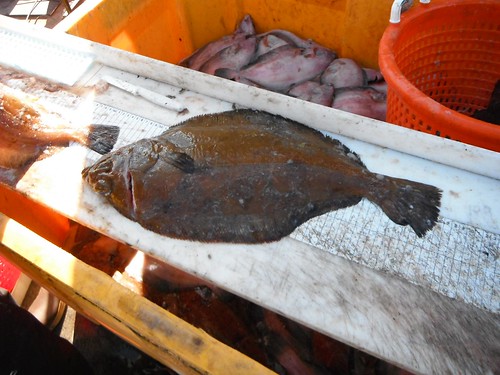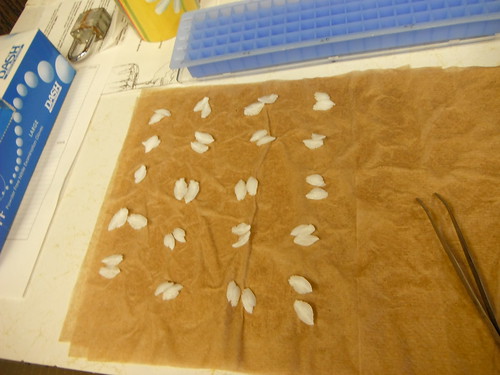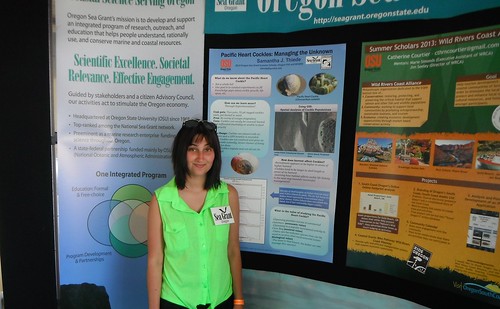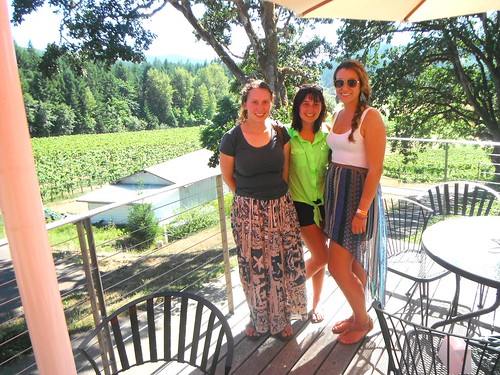WOW! I feel as if I have left the country and that I am living in an entirely different world. I have never seen so many Subaru cars in my life or beards! All in all, I am having a fantastic time here in Corvallis and I am loving my project. Since my last blog post, I have had the pleasure of attending the 3rd Tribal Environmental Health Summit held here in Corvallis, OR and have had the opportunity to speak with high school students from various summer programs about my experience as a college student and Oregon Sea Grant scholar. My project is quite challenging as I attempt to navigate my time meeting with administrators and program directors affiliated with various organizations and universities across Oregon and the country. Despite some difficulties, everyone that I have met thus far has been very welcoming and helpful with the project. I have not had the opportunity to visit the Confederated States of Siletz Indians reservation yet, but hopefully I will be able to make a visit there soon.
As far as my own Oregon adventures outside of my work environment, I have been able to visit quite a few places since my arrival. To begin, I went river rafting for the first time in my life from Corvallis to Albany which was quite the adventure of me trying not to freak out about drowning. :) I have also managed to make quite a few friends from the REU and other summer programs here on campus. Our groups have had the chance to visit some of the local hiking spots around the city and we go to the Farmer’s Market from time to time. One weekend we went on a coastal road trip to see the Sea Lion caves, visit Newport, and to hike up a random trail alongside the highway with spectacular views. We spent the Fourth of July watching fireworks from the riverfront downtown and have gone to the movies a couple of times, as well as, discovering some awesome dinner spots along the way. (Although, I do have to say that one of the only things I miss about AZ is the food. For example, I have had a pulled pork sandwich without any barbecue sauce because the owner does not “believe” in barbecue sauce and I just had a Huevos Rancheros dish made with Spaghetti Sauce!!! That is unacceptable!!!) Sorry, but I LOVE my Southwestern and Mexican food with a passion! Finally, last weekend we hiked the South Sister summit which was one of the most challenging hikes I have EVER completed in my life! At 10,380 I thought I was going to die from exhaustion, but in reality I survived with just sunburns. It was a breathtaking sight that I will never forget and one of the most beautiful views I have ever seen on this planet, simply time stopping. Afterwards, we drove to Bend to be tourists and explored a nearby cave where we had to crawl on our bellies to reach the end of that underground trail! We then ended our trip by stopping at the Dee Wright Observatory in the Willamette National Forest to check out some volcanic rocks and to see some more mountains in the distance.
I am thankful for all of the academic and non-academic activities I have had the pleasure of experiencing over the last few weeks. I am beyond thankful to be an Oregon Sea Grant scholar this summer and to have the opportunity to share my aid to the OSG-OSU project. Now I must hurry to pack my bags once again as I head to Crater Lake for the weekend! Until the next blog everyone and thank you for reading!!! :)
Tag Archives: Corvallis
There Are Trees and Rivers Here!!!
Hello Everyone!!! My name is Fatima Molina and I am from the beautiful city of Flagstaff, Arizona. I am beyond excited to be a part of the 2018 Oregon Sea Grant Summer Scholars cohort this summer and for all of the experiences that are bound to happen! I have never been to the state of Oregon before, but as soon as I step off the airplane in Portland I fell in love. I was used to having the San Francisco Peaks and ponderosa pine trees in my backyard growing up in Flagstaff, but during my time at the University of Arizona in Tucson I was surrounded by the hot desert filled with spiky cacti and poisonous animals (although Tucson did have some stellar sunsets).
This summer I am stationed on the Oregon State University (OSU) campus, where I am helping OSU faculty develop a Native American College Readiness Program for students from the Confederated Tribes of Siletz Indians, as well as, for other Native American tribes around the country. Part of my role is to investigate similar programs established at other post-secondary institutions and to build a correspondence between their administrators and OSU faculty. I will also be working with OSU faculty to develop an IRB-approved survey and protocol for interviewing focus groups to identity barriers to high school graduation and college enrollment. I am super excited to be helping OSU develop this important program to reach out to Native American communities around the country and to further increase diversity and inclusion on the OSU campus. As a Native American myself, it is always fantastic to witness higher education institutions take the initiative to recognize, form communication bridges, and help Native American students receive their Bachelor, Master, and Ph.D. degrees. I am also excited to learn more about the Confederated Tribes of Siletz Indians in the Pacific Northwest and the history of their tribes. There is a Pow Wow in early August that I would love to attend and if anyone is interested in joining me that would be great! Just let me know!
In the meantime, I will definitely be taking advantage of the local opportunities here on campus, in Corvallis, and throughout Oregon. This past weekend I visited a superb bookstore in downtown Corvallis and walked along a chill bridge across the river. I am not exactly tech savvy so I failed at uploading photos with this blog, but I will try to figure it all out by the next one! Thanks for taking the time to read about me and my project! :D
Week 5: Time Flies When You’re Having Fun!
Where has the time gone? Week five is completed, which means I’m halfway through my internship. This week was especially exceptional. Scott and I have continued our red rock crab surveys with much more success in capturing red rocks than in the past few weeks. I’ve also started on writing up a memo for the cockle experimental methods we’ve been developing and it’s awesome to finally put my scientific writing abilities to the test.
On Wednesday Dean Headlee invited me to come along with him to Hallmark, a fish processing plant. We intercepted two boats—the Apache and the Nel Ron Dic—as they brought in their trawl catches. It was our job to sample these fish (30-50 fish per sample by species). I was excited to handle so many species of fish such as green stripes, ling cod, Dover sole, English sole, big skates, long-nosed skates, yellowtail rockfish, and albacore tuna. We took the lengths (fork or total length, depending on the fish species), weight, sex and stage of sexual maturity, and we also pulled otoliths. After watching Dean pull several otoliths from the fish he let me give it a try and I was actually quite good at it!
Pulling otoliths, in my opinion, is an art form. If you don’t cut into the right place or know the right place to look you may never find them. However, Dean’s technical lesson of otolith pulling had me removing them like a pro in no time. The majority of the fish that we pulled otoliths from were flatfish. In order to pull an otolith from a flatfish you must first cut along the operculum (gill flap). This is where the art comes into play; you just have to know exactly where on the operculum to cut by doing it yourself and seeing what works, verbal instructions will only get you so far. Eventually, with practice, you just know where to cut into.
Once you’ve cut into the head you must find and remove the otoliths. Typically they sit on the right side of the cut (if you do it correctly). They are very small and in a fluid-filled pouch but once I had practiced on a few fish I could pull them blindly without even needing to see them. We put all the otoliths into individual slots in trays and assigned a number to them so we could age the fish later on.
As it being week five, it was time for all the Sea Grant Summer Scholars to attend our mid-summer check-in. Catherine, a fellow scholar, and I drove up to Corvallis on Thursday evening. It was awesome to ride with her as the scholars are pretty spread out through Oregon and we don’t get to interact much with each other.
Friday was the mid-summer check-in. We started off the morning with a presentation about outreach, which was definitely an eye-opener. Our speaker, Shawn, spoke with us on the public’s perceptions of scientists and how the public uses those perceptions to draw conclusions and form ideas and opinions. We also did an activity that helped us to understand how to guide others to conclusions about scientific material so that the information is absorbed.
It was great to finally spend time with my fellow summer scholars. Sunday, before we all parted ways, a few of us grabbed tubes and floated the Willamette. I had never floated a river before and it was such a relaxing experience (though the water was a little chilly!). The backdrop of the mountains as we floated down the Willamette was simply gorgeous; I couldn’t have dreamed up more beautiful scenery myself!
I was gone for a four day weekend and what do I come back to find on my desk waiting for me? Dead fish to be identified, a bag of shells, and a crab molt. Most people come back to desks piled with paperwork; I come back to dead animals. Life of a biologist, everyone! I wouldn’t trade it for anything.
This week I will be heading to Astoria with Steven Rumrill to do razor clam surveys and I am beyond thrilled! Until next time!





